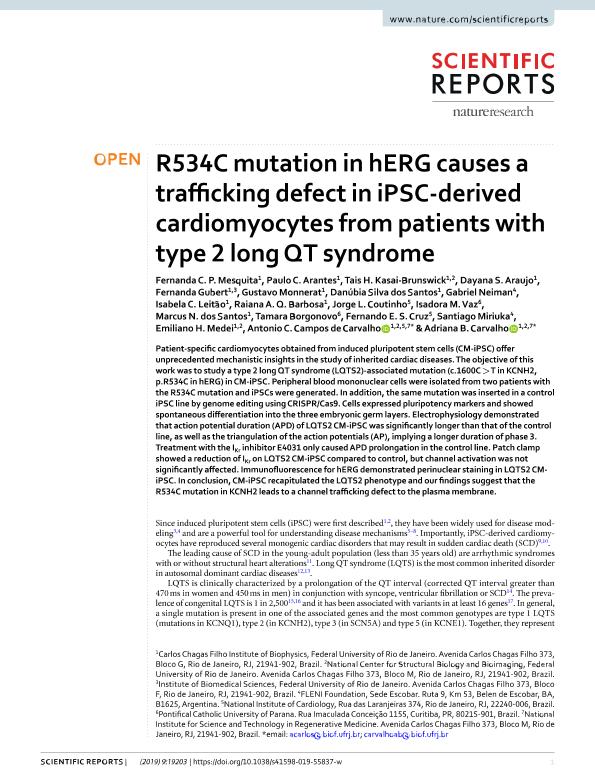Artículo
R534C mutation in hERG causes a trafficking defect in iPSC-derived cardiomyocytes from patients with type 2 long QT syndrome
Mesquita, Fernanda C. P.; Arantes, Paulo C.; Kasai Brunswick, Tais H.; Araujo, Dayana S.; Gubert, Fernanda; Monnerat, Gustavo; Silva dos Santos, Danúbia; Neiman, Gabriel ; Leitão, Isabela C.; Barbosa, Raiana A. Q.; Coutinho, Jorge L.; Vaz, Isadora M.; dos Santos, Marcus N.; Borgonovo, Tamara; Cruz, Fernando E. S.; Miriuka, Santiago Gabriel
; Leitão, Isabela C.; Barbosa, Raiana A. Q.; Coutinho, Jorge L.; Vaz, Isadora M.; dos Santos, Marcus N.; Borgonovo, Tamara; Cruz, Fernando E. S.; Miriuka, Santiago Gabriel ; Medei, Emiliano H.; Campos de Carvalho, Antonio C.; Carvalho, Adriana B.
; Medei, Emiliano H.; Campos de Carvalho, Antonio C.; Carvalho, Adriana B.
 ; Leitão, Isabela C.; Barbosa, Raiana A. Q.; Coutinho, Jorge L.; Vaz, Isadora M.; dos Santos, Marcus N.; Borgonovo, Tamara; Cruz, Fernando E. S.; Miriuka, Santiago Gabriel
; Leitão, Isabela C.; Barbosa, Raiana A. Q.; Coutinho, Jorge L.; Vaz, Isadora M.; dos Santos, Marcus N.; Borgonovo, Tamara; Cruz, Fernando E. S.; Miriuka, Santiago Gabriel ; Medei, Emiliano H.; Campos de Carvalho, Antonio C.; Carvalho, Adriana B.
; Medei, Emiliano H.; Campos de Carvalho, Antonio C.; Carvalho, Adriana B.
Fecha de publicación:
12/2019
Editorial:
Nature Publishing Group
Revista:
Scientific Reports
e-ISSN:
2045-2322
Idioma:
Inglés
Tipo de recurso:
Artículo publicado
Clasificación temática:
Resumen
Patient-specific cardiomyocytes obtained from induced pluripotent stem cells (CM-iPSC) offer unprecedented mechanistic insights in the study of inherited cardiac diseases. The objective of this work was to study a type 2 long QT syndrome (LQTS2)-associated mutation (c.1600C > T in KCNH2, p.R534C in hERG) in CM-iPSC. Peripheral blood mononuclear cells were isolated from two patients with the R534C mutation and iPSCs were generated. In addition, the same mutation was inserted in a control iPSC line by genome editing using CRISPR/Cas9. Cells expressed pluripotency markers and showed spontaneous differentiation into the three embryonic germ layers. Electrophysiology demonstrated that action potential duration (APD) of LQTS2 CM-iPSC was significantly longer than that of the control line, as well as the triangulation of the action potentials (AP), implying a longer duration of phase 3. Treatment with the IKr inhibitor E4031 only caused APD prolongation in the control line. Patch clamp showed a reduction of IKr on LQTS2 CM-iPSC compared to control, but channel activation was not significantly affected. Immunofluorescence for hERG demonstrated perinuclear staining in LQTS2 CM-iPSC. In conclusion, CM-iPSC recapitulated the LQTS2 phenotype and our findings suggest that the R534C mutation in KCNH2 leads to a channel trafficking defect to the plasma membrane.
Palabras clave:
LONG QT SYNDROME
,
IPS
Archivos asociados
Licencia
Identificadores
Colecciones
Articulos(SEDE CENTRAL)
Articulos de SEDE CENTRAL
Articulos de SEDE CENTRAL
Citación
Mesquita, Fernanda C. P.; Arantes, Paulo C.; Kasai Brunswick, Tais H.; Araujo, Dayana S.; Gubert, Fernanda; et al.; R534C mutation in hERG causes a trafficking defect in iPSC-derived cardiomyocytes from patients with type 2 long QT syndrome; Nature Publishing Group; Scientific Reports; 9; 1; 12-2019; 1-9
Compartir
Altmétricas



